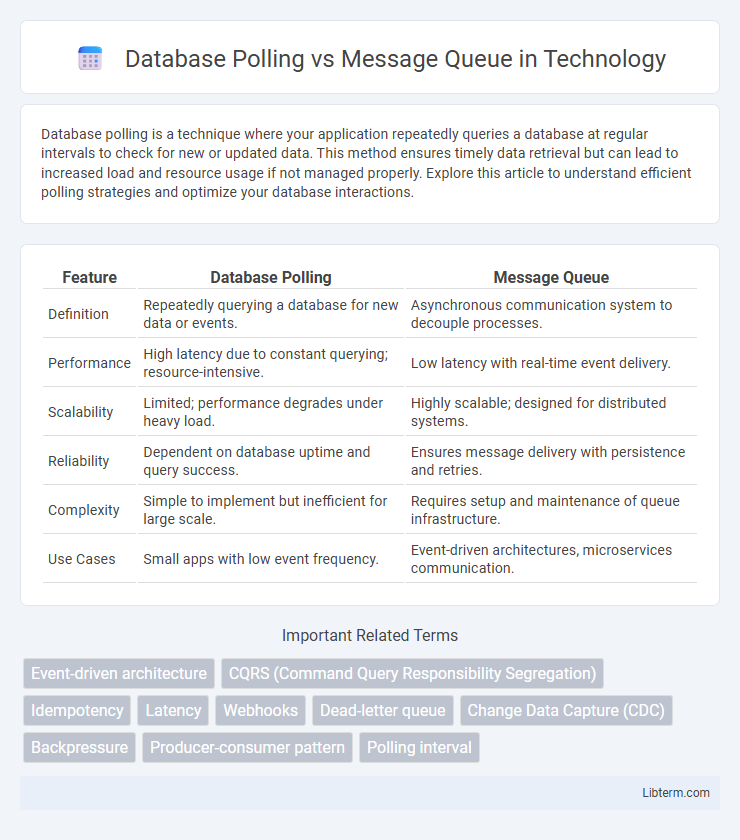Database polling is a technique where your application repeatedly queries a database at regular intervals to check for new or updated data. This method ensures timely data retrieval but can lead to increased load and resource usage if not managed properly. Explore this article to understand efficient polling strategies and optimize your database interactions.
Table of Comparison
| Feature | Database Polling | Message Queue |
|---|---|---|
| Definition | Repeatedly querying a database for new data or events. | Asynchronous communication system to decouple processes. |
| Performance | High latency due to constant querying; resource-intensive. | Low latency with real-time event delivery. |
| Scalability | Limited; performance degrades under heavy load. | Highly scalable; designed for distributed systems. |
| Reliability | Dependent on database uptime and query success. | Ensures message delivery with persistence and retries. |
| Complexity | Simple to implement but inefficient for large scale. | Requires setup and maintenance of queue infrastructure. |
| Use Cases | Small apps with low event frequency. | Event-driven architectures, microservices communication. |
Introduction to Data Communication Patterns
Database polling involves continuously querying a database at regular intervals to check for new data or updates, which can lead to increased latency and resource consumption. Message queues enable asynchronous communication by allowing producers to send messages to a queue that consumers can process independently, improving scalability and decoupling system components. These core data communication patterns are essential for designing efficient, reliable, and responsive distributed systems.
What is Database Polling?
Database polling involves repeatedly querying a database at regular intervals to check for new or updated data, enabling applications to detect changes without continuous database connections. This method can introduce latency and increased load on the database since it relies on periodic checks rather than event-driven notifications. Unlike message queues, which push messages to consumers immediately, database polling pulls data incrementally, often resulting in slower response times and less efficient resource utilization.
How Message Queues Work
Message queues function by storing messages in a queue until they are processed and acknowledged by consumers, enabling asynchronous communication between distributed systems. Each message contains the data or command that needs to be processed, and the queue ensures reliable delivery, load balancing, and decoupling of producers and consumers. This approach reduces latency and improves system scalability compared to database polling, where continuous querying can lead to increased load and delayed responsiveness.
Key Differences Between Polling and Messaging
Database polling involves repeatedly querying a database at fixed intervals to check for new data, which can lead to increased latency and higher resource consumption. Message queues enable asynchronous communication by pushing messages to consumers as they arrive, reducing response time and improving system scalability. Key differences include polling's reliance on periodic checks versus messaging's event-driven delivery, impacting efficiency, throughput, and resource utilization.
Performance Considerations
Database polling often results in increased latency and higher resource consumption due to frequent querying and data retrieval overhead, which can degrade overall system performance under heavy load. Message queues optimize performance by enabling asynchronous processing and reducing the need for constant database access, facilitating better scalability and lower response times. Implementing message queues like RabbitMQ or Kafka supports load balancing and fault tolerance, significantly enhancing throughput compared to database polling.
Scalability and System Load
Database polling can lead to increased system load and limited scalability due to frequent, repetitive queries that consume database resources and cause latency under high traffic. Message queues enhance scalability by decoupling services and enabling asynchronous communication, which distributes load more evenly and reduces bottlenecks. This approach supports higher throughput and better resource management in large-scale, distributed systems.
Reliability and Data Consistency
Message queues offer higher reliability and data consistency by ensuring ordered message delivery and built-in retry mechanisms, reducing the risk of message loss or duplication. Database polling, relying on periodic queries, can lead to data staleness and increased latency while facing challenges in handling concurrency conflicts and ensuring atomicity. In high-throughput systems requiring fault tolerance, message queues provide stronger guarantees for reliable processing and consistent state management compared to database polling.
Use Cases for Database Polling
Database polling is ideal for simpler applications requiring periodic data synchronization without complex infrastructure, such as legacy systems or small-scale batch processing jobs. It is effective when updates are infrequent and latency tolerances are higher, for example, in reporting dashboards or inventory updates that do not demand real-time responsiveness. This approach offers straightforward implementation and maintenance, making it a practical choice for scenarios with limited resources or minimal event-driven requirements.
When to Choose Message Queues
Message queues are ideal when system scalability and asynchronous communication are critical, enabling efficient handling of high-throughput workloads without overloading the database. They provide reliable message delivery, fault tolerance, and decoupling of services, which is essential for microservices architectures and event-driven systems. Choosing message queues enhances real-time data processing, reduces latency, and improves overall system resilience compared to database polling strategies.
Best Practices and Recommendations
Database polling often leads to increased latency and resource consumption due to continuous querying, making it less efficient for real-time data processing. Message queues, such as RabbitMQ or Apache Kafka, offer asynchronous communication with better scalability and reliability by decoupling producers and consumers. Best practices recommend using message queues for event-driven architectures and high-throughput systems, reserving database polling for simple, low-frequency tasks where implementing a message queue is not feasible.
Database Polling Infographic

 libterm.com
libterm.com